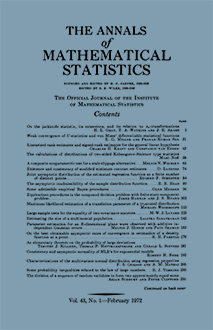Abstract
The distinction between efficiency in the asymptotic sense originally introduced by Fisher ([2], 1925, p. 703), and the finite sample sense sometimes used by others has been recently stressed by various writers (e.g., Berkson [1]). The technique of proof used below was originally developed to provide a simple example where the maximum likelihood estimate of location, though asymptotically efficient, was not of minimum variance for any finite sample size whatever. The (symmetrical) double exponental distribution with known scale, where the sample median is the maximum likelihood estimator of location, could easily be shown to be such an example. (While this result is useful in deflating unwarranted views about minimum variance properties of maximum likelihood estimates, Fisher's ([2], p. 716) results about intrinsic accuracy in the same situation are of more basic interest.) On examination, however, the technique used to provide this rather isolated and special result was found capable of showing, for a class of distributions with suitable monotony properties (in particular all distributions for which $f'(y)/f(y)$ is monotone decreasing, and all normal, exponential, gamma and beta distributions), that the covariances of the order statistics in a sample of any chosen size are monotone in either index separately.
Citation
John W. Tukey. "A Problem of Berkson, and Minimum Variance Orderly Estimators." Ann. Math. Statist. 29 (2) 588 - 592, June, 1958. https://doi.org/10.1214/aoms/1177706637
Information





